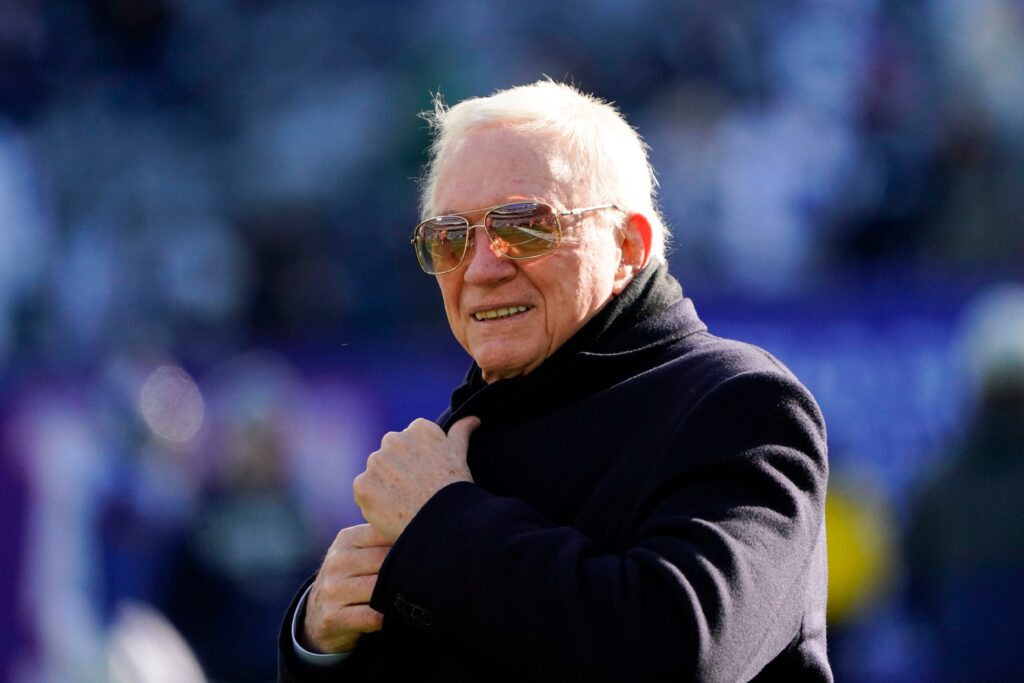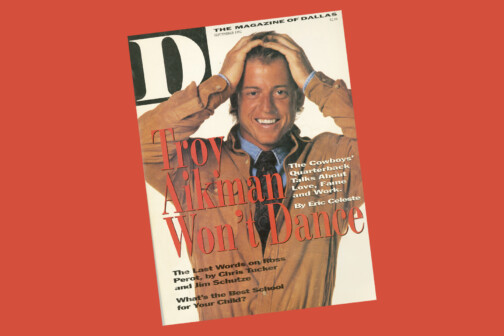One of my favorite things to do with a Dallas Cowboys story is to take something that everyone’s getting excited about it and then immediately poo-poo it. Enter the whole “Jerry Jones talking about trading up in this year’s NFL Draft” scenario, which emerged from his comments to the assembled media after he announced a partnership with a cryptocurrency company called blockchain.com.
“I would trade up since we’re down as low as we are, in those first two, three rounds, if we had a chance to and someone we really coveted was sitting at the bottom,” he said. “If [a Travis] Frederick was sitting down there at the bottom and we were able to trade up there and get them.”
We’ll have to do some work to interpret what Jerry is saying here because the Cowboys didn’t trade up to pick Travis Frederick. They traded down 13 spots in the first round of the 2013 draft with San Francisco to select Frederick while adding a third-round pick in the deal, which they used to select Terrance Williams. And that move is absolutely relevant in forming an opinion of how likely the Cowboys really are to trade up in 2022 draft, both because of the how the Frederick trade happened and what followed.
When the Cowboys were on the clock at No. 18, the top player on their draft board was a defensive tackle out of Florida named Sharrif Floyd. One problem: they also had a defensive coaching staff who said he didn’t fit what they wanted to do. That mis- or non-communication between the scouting and coaching sides of the building led to what I refer to as the Will McClay era. McClay had been with the Cowboys since 2009 but became the assistant director of player personnel in 2014. He became the guy responsible for making sure there were bridges between the front office, scouting department, and coaching staff. This is intuitive: it doesn’t make a lot of sense to have scouts watching players and ranking them without the input of exactly what the coaching staff and front office want from each position. But 2013 showed us that such communication can’t be taken for granted, and McClay has done a great job fostering it in the years since.
Since the start of the McClay era marks such a fundamental shift in how the organization operates, if I’m looking for tendencies of how the Cowboys currently approach the draft, what matters is 2014 to the present day.
So, before we go back to Jerry, let’s take a look at every first-round pick since then:
2014: Zack Martin
2015: Byron Jones
2016: Ezekiel Elliott
2017: Taco Charlton
2018: Leighton Vander Esch
2019: None (pick traded for Amari Cooper)
2020: CeeDee Lamb
2021: Micah Parsons
If you’re looking for how many of guys the Cowboys have traded up for in this span, the number is “zero.”
In my opinion, this is a good thing. In a vacuum, trading up for any non-quarterback is a bad idea. There’s too much failure in drafting, which makes the success of any trade-up too reliant on your ability to put the players in the draft in an exact order of how good they’re going to be in the NFL. That doesn’t mean you can’t be right when you target a specific player and go after him. Just that, on average, the team trading down “wins” draft-day trades more often since they end up having more darts to throw at the board and, hence, more chances to find good players.
So, Jerry’s comments notwithstanding, history tells us it’s unlikely the Cowboys are trading up, at least not in the first round. An idea that I’m more open to would be what the Cowboys did in 2014, McClay’s first year of serious influence in the draft process. That year, they picked 16th in the first round and selected Zack Martin, which has worked out pretty darn well. When the first round was over and they had time to regroup ahead of the next day of drafting, they prioritized finding a way to get who they considered the last top-tier pass rusher in the draft. So they traded up in the second round to draft DeMarcus Lawrence, which has also worked out great (contrary to what a portion of the fan base might think).
Armed with the past (what they tend to do) and the present (what this roster currently looks like), we can make an educated guess about the future (what they’re likely to do if a trade is involved).
First, they’re most likely to sit at 24 and pick the best player who falls to them. Failing that, if they go anywhere in the first round, it will almost certainly be down instead of up, because on average such a move works out better. There’s recent precedent for this, as Dallas acquired an extra third-rounder last year by agreeing to slide back to No. 12 to select Micah Parsons. There’s also a logical reason for it. This roster needs immediate help at offensive line, defensive line, and wide receiver, and the likelihood of a player becoming an NFL starter drops below 30 percent once you get outside the third round. Dallas could use as many of those picks as it can get, and moving back in the first is probably the easiest way add one.
Lastly, for those of you who love to trade up, keep an eye on the second round if a player at a premium position—pass rusher, receiver, offensive tackle, cornerback—is both available and the final player they view as being in a certain tier of prospect.
Scenario time. Just for fun, let’s say the Cowboys select their new starting left guard in the first round (I’ll continue to say Zion Johnson out of Boston College or Kenyon Green out of Texas A&M). That would still leave a need at a premium position in wide receiver, and you can see how I order them—along with the rest of my draft evaluations—on my draft board. Then we’ll look at the receivers in this draft class. The way I have them graded is in order here. I’d really like to get one of the guys in the top three tiers, so perhaps doing so means packaging the second-round pick and some of the surplus picks on day three to go up and ensure you get a premium prospect at a premium position before a tier runs out. It worked with Tank Lawrence back in 2014. This might be the year for a sequel.
But none of that will involve a move up in the first round. Any suggestion otherwise is just more noise, of which there is plenty at the moment. Now is what they call “lying season” in the NFL, as teams try to somewhat veil their plans for the draft. It’s mostly a silly exercise because every team in the league employs people whose job it is to know what other teams need. There are no real secrets, and past precedent tells us plenty about what the Cowboys tend to do in the McClay era. So Jerry Jones can say what he wants about trading up. It likely isn’t happening.
Author







